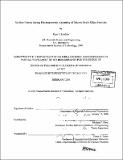Surface forces during electrophoretic assembly of micron scale silica particles
Author(s)
Kershner, Ryan J. (Ryan Joseph), 1976-
DownloadFull printable version (4.107Mb)
Other Contributors
Massachusetts Institute of Technology. Dept. of Materials Science and Engineering.
Advisor
Michael J. Cima.
Terms of use
Metadata
Show full item recordAbstract
A system of platinum microelectrodes was fabricated on a sapphire substrate by lithographic patterning and used to manipulate 1.58 [mu]m silica particles in-plane. A digital video system was used to image the motion of particles far from the electrodes and their deposition onto the working electrode during application of a DC potential. The role of electrode reversibility was investigated and the performance of the as-deposited electrodes was improved by electrolytic plating of platinum. Particles were also seen to adhere to the substrate before reaching the electrode. Force distance curves were recorded using a colloid probe atomic force microscopy technique to directly measure the interaction of the silica particles with the sapphire substrate. This data validated the observed adhesion at the electrode and provided further support for the temporal and spatial reduction in pH. The role of Faradaic processes and the diffusion of potential determining ions in electrophoretic deposition was also considered. The zeta potential of planar sapphire substrates for three different crystallographic orientations was measured by a streaming potential technique in the presence of KCl and (CH3)4NCl electrolytes. The streaming potential was measured for large single crystalline C-plane (0001), A-plane (1120), and R-plane (1102) wafers over a full pH range at three or more ionic strengths ranging from 1 to 100 mM. The results reveal a shift in the iso-electric point (i.e.p.) of the three samples by as much as two pH units, with the R-plane surface exhibiting the most acidic behavior and the C-plane samples having the highest i.e.p. (cont.) The acidity of the sapphire wafers is explained in terms of an absence of adsorbed hydroxyl groups for these surfaces prepared at room temperature. Modified Auger parameters (MAP) were calculated from XPS spectra of a mono-layer of iridium metal deposited on the sapphire by electron beam deposition. A shift in MAP consistent with the observed differences in i.e.p. of the surfaces confirms the effect of surface structure on the transfer of charge between the Ir and sapphire, hence accounting for the changes in acidity as a function of crystallographic orientation.
Description
Thesis (Ph. D.)--Massachusetts Institute of Technology, Dept. of Materials Science and Engineering, 2004. Includes bibliographical references (p. 115-120).
Date issued
2004Department
Massachusetts Institute of Technology. Department of Materials Science and EngineeringPublisher
Massachusetts Institute of Technology
Keywords
Materials Science and Engineering.